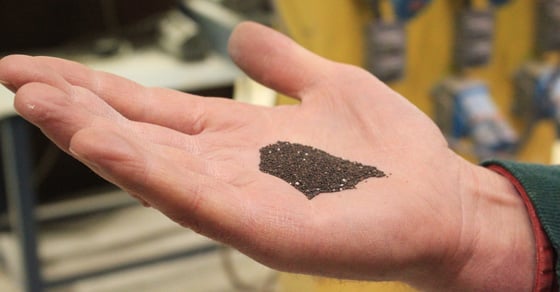While the oil and natural gas industry has had its ups and downs, many speculate it is again poised for growth due to the current political climate. Subsequently, there is a renewed interest around proppants – the hard microspheres injected into well bores to “prop open” rock fissures allowing natural gas and oil to flow out. According to the Fredonia Group, North American proppant demand looks set to grow at an annual rate of 7.6% through 2019.
Frac sand, or silica sand, a naturally made, abundant quartz sand, is the most commonly used proppant due to its low cost and high availability. However, while frac sand offers an economic solution in most cases, some settings require a bit more ingenuity on behalf of the proppant.
Ceramic proppants – a man-made proppant, offer a tailored solution in more demanding drilling settings.
Benefits of Ceramic Proppants
While ceramic proppants cost more than their naturally-made counterparts, they do offer advantages that make them the preferred choice in some settings, because they are capable of maximizing the yield from a given well. These advantages include:
Greater Crush Strength
As well bores get deeper, the pressure on proppants gets higher, and frac sand is not always up to the task.
Ceramic proppants can withstand a much greater crush strength than traditional frac sand products – up to 10,000 psi.¹ This allows drillers to access much deeper shale formations.
Higher Conductivity
Ceramic proppants also boast a number of characteristics that translate to better conductivity, or the effectiveness at which the petroleum product can flow around the proppants in the rock fissure.
Improved uniformity in size, shape, and overall sphericity allows natural gas or oil to more easily flow around ceramic proppants in the well bore.
Conductivity is further improved due to the stable thermal and chemical nature of ceramic proppants; there is much less risk for the proppant to thermally or chemically react with the shale formation causing an undesirable deposit to form, which would ultimately clog the fissure.¹
Tailored Solutions
Because they are manmade, the characteristics of ceramic proppants can be much more tightly controlled than with sand products. Proppants can be selected based on a variety of engineered characteristics to offer a more tailored solution to the specific needs of a well site.
Within the category of ceramic proppants, proppants are also available in three sub-categories, with higher density proppants able to withstand greater stress:
- Lightweight Ceramic
- Intermediate Density Ceramic
- High Density Ceramic
Ceramic Proppant Production
Ceramic proppants can be made from a variety of materials. While most are made from bauxite, kaolin (aka China Clay), or a blend of the two materials, a variety of other materials may be used, including magnesium silicate and fly ash. Various additives may also be included.
The manufacturing process of ceramic proppants can differ, but in general, proppants follow the process described below.
Crushing
Raw materials are crushed into powder form. Materials and additives may be mixed in to develop specialized formulations in order to maximize performance of the end product.
Pelletizing
The powdered raw material is then pelletized to create a uniform, round pellet/granule product. Proppant sizing is a critical factor in the performance of a proppant at a given well and as such, producers often provide a wide offering of mesh sizes. Proppants are typically between 8 and 140 mesh and it is not uncommon to use multiple sizes at a given well.¹
Drying
Once agglomerated, pellets are dried to reduce the moisture content of the material. This is typically carried out in a rotary dryer or other type of industrial drying system. Pellets are classified via screening.
Sintering
Perhaps the most important step in the process, on-size pellets are sintered in a rotary kiln to “cure” the pellets. This high temperature sintering, which occurs at around 2700 – 2900º F, causes chemical and crystalline changes in the material, causing it to harden further, ultimately imparting the crush strength that will be required for high pressure drilling applications.
Cooling
The hot material exits the kiln and is fed to a rotary cooler. The cooler cools the hot product so it can move on to storage or transport.
Ceramic Proppant Development
When working with ceramic proppants, feasibility testing and process development are often an integral part of developing specialized proppants. Source materials are often tested first at batch scale to confirm feasibility, then at continuous pilot scale in rotary kilns designed to simulate production conditions, depending on the capabilities of the testing facility.
Testing not only confirms feasibility of the intended process with the unique source material, but it also provides the data necessary, such as time and temperature profiles, for process scale-up and the design of a commercial scale unit.
Conclusion
While ceramic proppants make up a small portion of the overall proppant market compared to frac sand, they are still a valuable tool in high stress settings. Their thermal and chemical stability, combined with a more uniform shape and size, and their high conductivity, make them a worthwhile alternative for more specialized applications.
FEECO provides feasibility testing and process development around the manufacture of ceramic proppants. In addition to our testing services, we engineer and manufacture custom rotary kilns to meet your proppant sintering needs, as well as rotary dryers and coolers for the proppant production process. For more information, contact us today!
1.F. Liang et al. A Comprehensive Review on Proppant Technologies. Petroleum 2 (2016) 26 – 39. Web. Feb. 2017.



